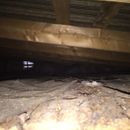How to deal with metal roof condensation?
Hello,
I have a detached 20′ x 23′ two storey garage, 100 yrs old, with an open room on the upper floor. The metal roof has a fairly serious condensation problem in late winter/Spring.
I’m in Climate Zone 6 – Montreal, Canada.
The current roof is an exposed-fastener steel corrugated gable. Around 2:12 – 3:12. The metal is screwed directly to purlins, on top of rafters, with no sheathing or underlayment. The attic floor is sloped old wooden boards covered in tar paper (I believe this was the original built-up flat roof). The additional gable structure was built on top of it.
There are two gable vents (around 1 foot square each). But there is no ridge vent nor are there any soffit vents. The ends of the corrugated metal panels are sealed with foam/caulking so there is no air at all coming in at the eaves.
There are no penetrations at all in the roof (there’s no plumbing, no HVAC vents in the building). Heat is electric baseboards.
The worst period for condensation is when the outside temp rises and the roof is still covered in snow and ice (the low slope means that snow tends to linger). There is a significant stream of water finding its way through the attic floor in those conditions.
I assume the metal stays at around zero degrees in those conditions – and interior temps tend to match or exceed the outside temperature.
At the moment the garage downstairs is unheated, and the upper floor (used presently for storage) is heated minimally, kept above zero.
There is no insulation on the attic floor at all. In the walls and floor of the upper floor there is 4″ – 6″ of fiberglass. The garage concrete slab is in poor shape and the building as a whole tends to be relatively humid.
I’d like eventually to fully seal off and insulate the upper floor, including the roof, in order to make the space usable in the winter.
I wonder if there are an solutions that do not involve ripping off the metal and re-roofing?
– Would adding soffit vents and a ridge vent reduce condensation or simply allow even more of the humid outside air to contact the metal and condense?
– Would air sealing the attic floor completely make a difference, given the lack of normal sources of interior humidity? (eg bathrooms)
– Would it be worth trying to add felt or synthetic underlayment to the existing metal roof, cutting it to go in between the purlins?
– Presumably spray foam on the underside of the metal roof itself would solve the issue but since it would be expensive, what’s the minimum thickness I would need? (also hard to access the eaves without removing the attic floor.)
I’d be very happy for any thoughts on this conundrum.
Many thanks in advance-
GBA Detail Library
A collection of one thousand construction details organized by climate and house part










Replies
Added picture of the exterior
Leo,
If the roofing panels are attached with screws, by far the easiest approach is to remove the roofing panels, add roofing underlayment (or even better, OSB sheathing plus underlayment), and then re-install the roofing panels.
If the roofing panels are attached with nails, all is not lost. in many cases, old nails have nearly worked themselves loose due to expansion and contraction, and are easy to pull without damaging the roofing. When the corrective work is complete, the roofing panels can be reinstalled with roofing screws (screws with rubber washers).
Many thanks Martin. It won't be easy to remove the panels since the screws are buried in various types of caulk but it's certainly worth trying.
Do you think it would be a good idea to add soffit vents and a ridge vent? And would blown-in (cellulose or fiberglass) or batts be the way to go for attic insulation?